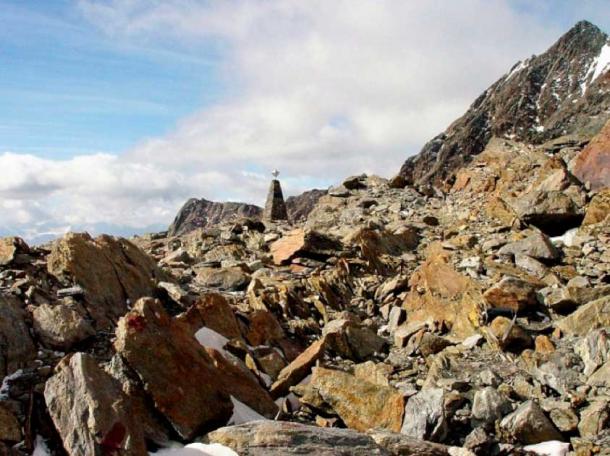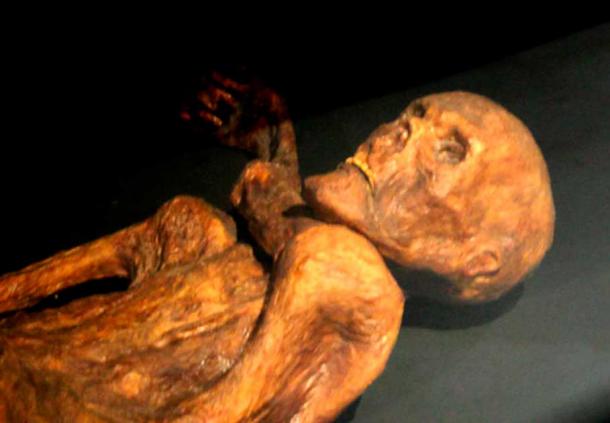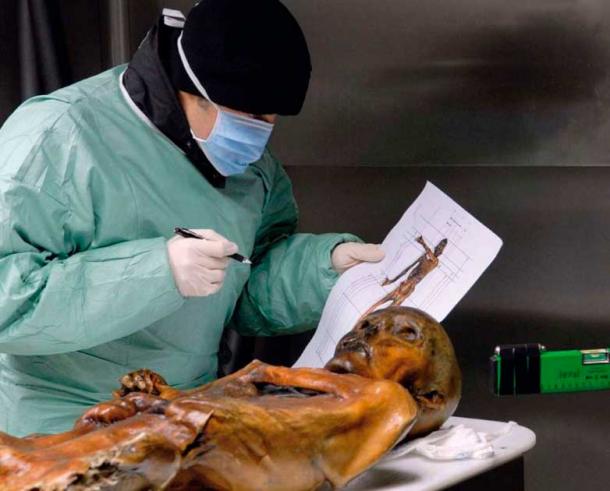
Ötzi the Iceman Took a Posthumous Ride on River of Ice Water
A new proposal by researchers of the oldest known naturally mummified corpse, better known as Ötzi the Iceman, questions both the time and place of his death. New analysis points towards the time of year being spring rather than autumn, and that the body was moved by ice melt from further up the mountain.
Iceman Analysis Heats Up
Since the perfectly preserved body of Ötzi the Iceman was first found by hikers in the Tyrolean Alps in 1991, the life and times of the 5,300-year-old mummy have been studied by a multitude of researchers seeking to unravel the clues of his existence. Treading the same path but producing a fresh hypothesis, the authors of a new study recently published in the journal Holocene declare that the conventional story of what happened to Ötzi after his death is in error. He probably did not die in the gully where he was found, the scientists responsible for this new research say, but was instead carried there after death by the strong summertime flow of melting ice water.
The body of Ötzi, the scientists say, has been buffeted about by the forces of nature for quite some time. The thawing and refreezing of glacial ice in the Tyrolean Alps has both moved him and preserved him, and ultimately carried him to a spot on the landscape where his discovery became possible.

Photo of the Ötzi the Iceman find site. (Professor Jim Dickson)
Significantly, the researchers believe that what Ötzi experienced following his death was not all that uncommon. They are now convinced that other prehistoric residents of the Alps likely died in the same region and could have had their bodies preserved by the same melting and freezing cycles that kept Ötzi´s corpse in nearly pristine condition for five millennia.
Speaking about the prospects of finding another melted prehistoric body at some point, "I think the possibility now is perhaps a bit larger," stated Norwegian archaeologist Lars Pilø, the lead author of the new study, in an interview with Live Science. "It’s not so large that I can promise there will be a body in the next decade, but I think that there’s definitely a chance."
- Ice Man, Otzi: A Treacherous Murder with Unexpected Links to Central Italy
- 5,300-Year-Old Otzi the Iceman Was Wearing Clothing from Five Separate Animal Species

Reconstruction of the Iceman. Prehistory Museum of Quinson, Alpes-de-Haute-Provence, France. (CC BY SA 3.0)
Ötzi the Holy Grail
When German tourists hiking the Tyrolean Alps in September 1991 first stumbled over the naturally mummified remains of Ötzi the Iceman’s body and reported it to authorities, no one was certain at first exactly what had been found. But tests by experts revealed the mummified man had lived and died 5,300 years ago, and had miraculously been preserved despite the immense passage of time.
It was eventually decided that Ötzi’s body must have been frozen in glacial ice until the summer of 1991, and then been exposed by the latest round of seasonal melting. The specific location where he was found was in a gully at 10,500 feet (3,200 meters) above sea level, in the Tisenjoch pass on the Italian side of the Italian and Austrian border (the Alps divide the two countries).
There is no way to overestimate the importance of finding such a well-preserved specimen from such an ancient time.
“Ötzi the iceman is the holy grail of glacial archaeology, nothing less,” Pilø stated, in a post published on the Secrets of the Ice glacial archaeology project website. Lars Pilø is the head of the Secrets of the Ice initiative, which is sponsored by Norway’s Innlandet County Council and the Museum of Cultural History at the University of Oslo. Archaeologists affiliated with the Project have been exploring and excavating extensively in the Alps, especially in high-altitude areas where glacial melt has exposed land that had been covered with ice for thousands of years.
These ongoing excavations have produced a wealth of artifacts left behind by ancient cultures. But so far, Ötzi the Iceman is a wholly unique find.
- Ice Man, Otzi: A Treacherous Murder with Unexpected Links to Central Italy
- 5,300-Year-Old Otzi the Iceman Was Wearing Clothing from Five Separate Animal Species

Scientific examination of the Ötzi mummy. (South Tyrol Museum of Archaeology /EURAC/Samadelli/Staschitz)
Ötzi’s Last Meal Reveals the Truth
Almost everything about Ötzi´s life story, and post-life story, for that matter, has remained open for speculation and debate. In particular scientists have been trying to figure out how he came to be found in such a remote location, looking freshly mummified despite the extreme passage of time.
Up to now, the accepted story of Ötzi´s death, first proposed by archaeologist Konrad Spindler from the University of Innsbruck, was that he had been murdered while traveling across the Alps. This conclusion was backed by solid evidence, as an examination of Ötzi´s mummified remains found an arrowhead embedded in his body and a deep cut in his hand. The backpack and the bow and arrow found with him were also damaged, which Spindler saw as further evidence that he had been killed during some type of violent attack.
He had been slain right where he was found, this theory proposed, and his body was subsequently protected for millennia by the glacial ice that eventually covered the gully where his body lay.
While not disputing that Ötzi lost his life in some type of battle, Pilø and his colleagues believe he was not killed where he was found. Instead, they believe he died in the early spring or summer while occupying the surface of a stationary ice patch somewhere else. As that ice patch thawed and refroze seasonally, the body of the Iceman was gradually washed down into the gully where it was ultimately found. Despite the periodic thawing of the ice, which would have exposed him to the open air on occasion, Ötzi was well-preserved inside the icy enclosures that surrounded his body most of the time.
One interesting consequence of this theory is that Ötzi may not have been alone at the time of his death. If he was not attacked individually but killed during warfare fought on an ice patch, some of his comrades in arms might have met the same fate as he—and perhaps some of them were swept away by melting ice water and eventually mummified, just like Ötzi. This is why Pilø believes another perfectly preserved prehistoric mummy might be found in the Alps in the not-too-distant future.
Lars Pilø and team did not reach their conclusion about Ötzi’s fate based on an accumulating body of evidence. They were instead swayed by one key piece of evidence, which emerged from an analysis of the contents of Ötzi’s stomach and intestines. An earlier study had revealed that his last meal consisted of wild ibex and red deer meat, cereals made from einkorn wheat, and some leaves from a toxic fern he may have ingested to combat parasites.
From what is known about the ecology of the Alps 5,000 years ago, it seems the food he ate would have only been available for harvest in the spring or early summer. At this time, the gully where his body was buried was fully covered with ice, meaning there was no way he could have died at that location.
The standard theory has always claimed that Ötzi died in the autumn, when the gully would have been ice-free. Sinking temperatures then would have arrived soon enough to freeze his body and cover it with ice before it could be picked apart by scavengers.
Did the Iceman Really Take a Long Bath? It May Be Possible to Find Out
If the scientists are right and Ötzi the Iceman was killed on an ice patch and carried to the gully by flowing ice water, it may be possible to find more evidence that backs this scenario.
This is according to archaeologist Andreas Putzer of the South Tyrol Museum of Archaeology in Bolzano in Italy, where Ötzi’s body and artifacts are displayed.
“A mummy submerged in water would lose its epidermis [skin], hair and nails,” Putzer told Live Science. "Normally this happens to bodies of drowned persons."
Assuming Putzer is right, a closer pathological examination could very well prove that the Iceman was submerged in water at different times over the past five thousand years. Even without that research, however, the evidence from Ötzi’s last meal should be more than enough to cast grave doubts on the viability of the original theory about how and where he died.
The full report by Lars Pilø et al. and published in Holocene can be found here.
Top image: The upper body of Ötzi, protruding from the ice in the Tisenjoch pass on September 19, 1991. Photo: Helmut Simon. Used with kind permission from Erika Simon. Source: Erika Simon/SAGE Journals
By Nathan Falde
















Comments
It’s the key question with history, my friend. It’s also the key question with yesterday’s ‘news’. But yesterday, there were people there who might say, ‘that’s not really what happened.’ So, when all the people who may have witnessed the actual event are gone, it’s anything goes. And they keep changing history! The books from a few hundred years ago, IF you can still find them, are radically different in what they tell us. Isaac Newton caught the Church altering dates to fit a false narrative/destroy a true one, and the Church responded by trying to destroy Newton’s reputation. The ‘stakes’ are apparently NOT low. I believe a zero was removed from Plato’s Atlantis timeline, rendering his narrative very dubious (so easy, by just striking a single digit of text), ...which IF you add the zero back, has the destruction of Atlantis at the EXACT time of the sudden emergence of the Ice Age (115k BC) and precipitating what nobody (but me) calls a 100k-year-long ‘nuclear winter’. So I would theorize that where somebody benefits by destroying the truth of history, there is 99.9% certainty it was altered (or evidence made to disappear), and is thus NOT TRUE, just a silly (but broadly/institutionally coordinated) narrative with many logical disconnects (that a culture of that day would prepare elaborate subterranean chambers for the sole purpose of holding dead bodies), like from Hollywood, but more amateurish. The question then becomes, who benefits, how and why, and why aren’t any ‘professionals’ in the field leading a concerted effort bring some light to the obvious fiction? Many of these angles would be VERY interesting, could sell, make somebody a name. And for sponsored projects, I would propose excavating under the Richat Structure/Atlantis, live-streaming it, making all PERFECTLY transparent for public eyes. Maybe use a Musk Boring machine or two, where the word ‘boring’ (opposing polarity of etymology: lack of interest, piercing), becomes an OXYMORON, like so much these days. Were a war to get in the way, we'd go ...hmmm, meh, same old?
Nobody gets paid to tell the truth.
How much history is wrong?
The answer is probably quite a lot. History tells us that, funnily enough.
Let’s think it through. We’re coming out of the Ice Age. Glaciers everywhere have been constantly reducing, not gaining. The science says we’ve been in that pattern for at least 15k years. We know the Ice Age began about 115-120k BC. So how can their dating be correct? Would have to be MUCH OLDER.
Nobody gets paid to tell the truth.